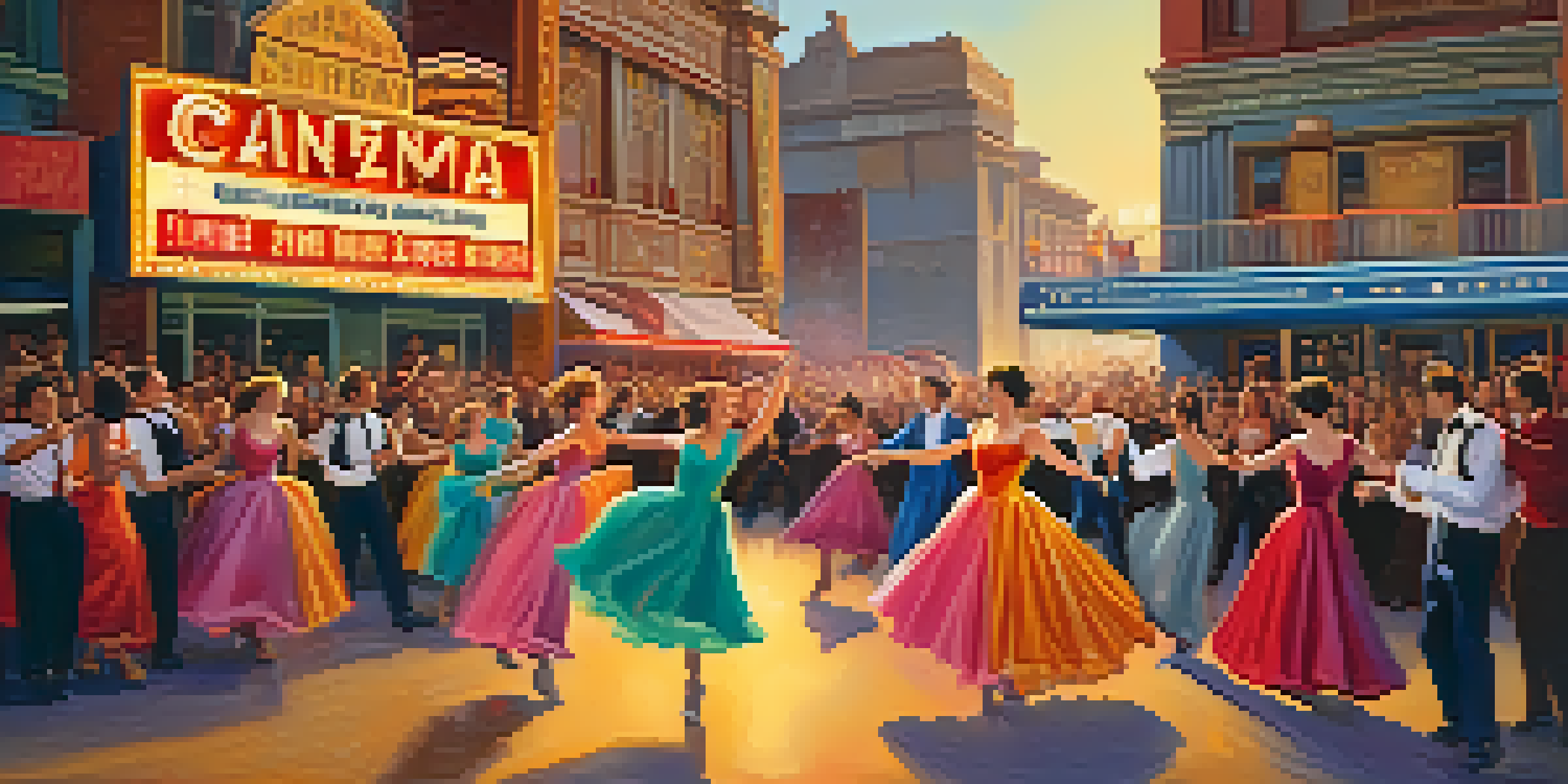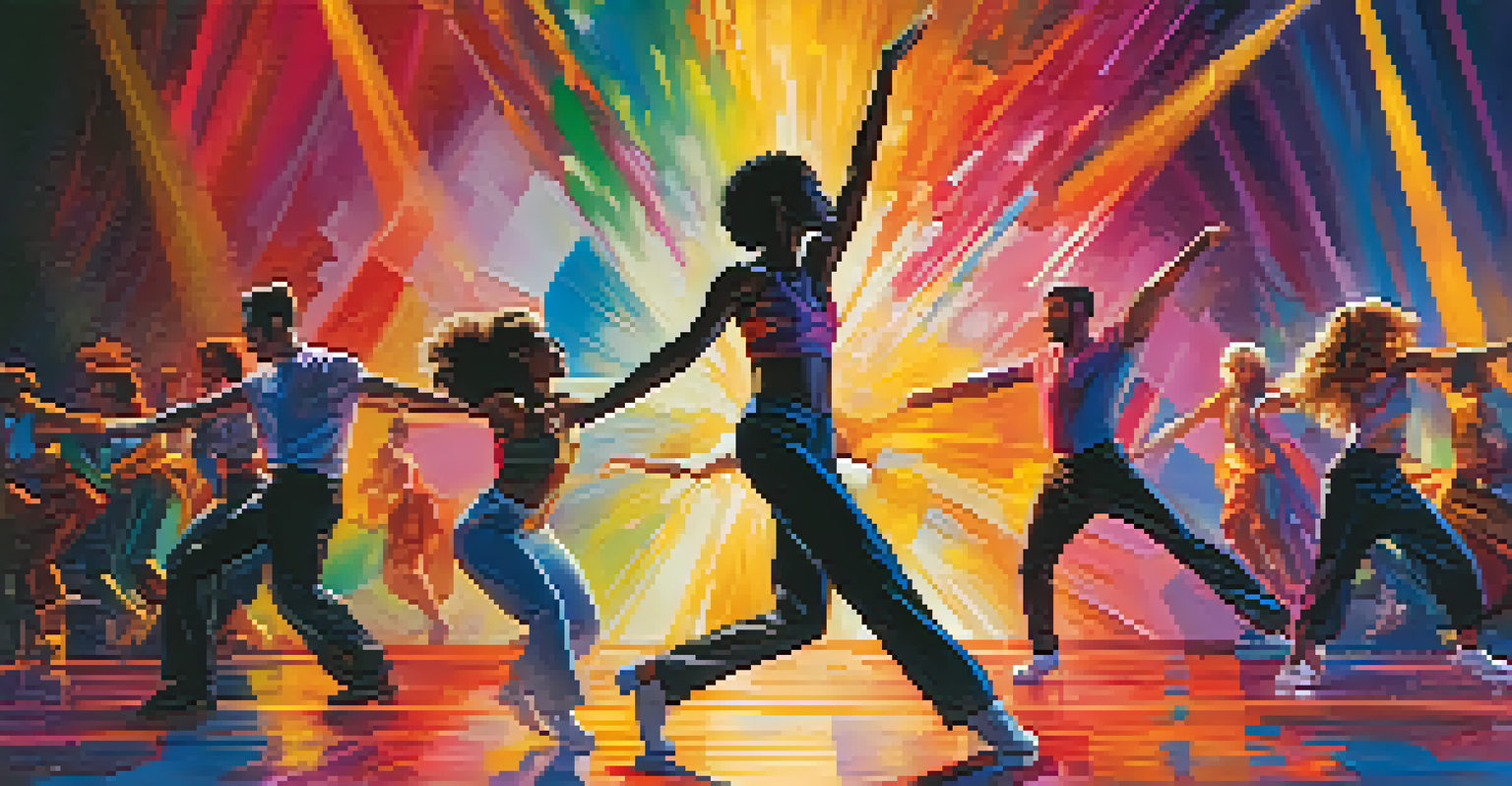The Rise of Musical Films and Their Cultural Impact

The Evolution of Musical Films in Cinema
Musical films have a rich history that dates back to the early 20th century, with classic examples like 'The Jazz Singer' paving the way. These films combined storytelling with song and dance, creating a captivating form of entertainment. Over the decades, the genre has evolved, embracing various styles and themes, from the grandiose spectacles of the 1950s to the edgier, more relatable narratives of modern times.
Musicals are the greatest form of entertainment ever created. They have the power to uplift, inspire, and bring people together.
Today, we see a resurgence of interest in musical films, with productions like 'La La Land' and 'The Greatest Showman' captivating audiences worldwide. This revival highlights not only nostalgia but also a renewed appreciation for the artistry involved in combining music with visual storytelling. As cultural tastes shift, musical films continue to adapt, reflecting contemporary issues while maintaining their core appeal.
The rise of streaming platforms has further fueled this evolution, allowing for a wider audience to discover and enjoy musical films. With more productions being made and distributed, the genre is no longer confined to theaters, making it more accessible than ever. This accessibility is reshaping how we engage with musical narratives, blending traditional elements with modern storytelling.
Cultural Significance of Musical Films
Musical films often serve as a mirror to society, reflecting cultural norms, struggles, and aspirations. For instance, films like 'West Side Story' tackled issues of race and class, resonating deeply with audiences during times of social upheaval. By intertwining music and narrative, these films can evoke powerful emotions, prompting viewers to reconsider their perspectives.

Moreover, musical films have the unique ability to transcend language barriers. A catchy tune or a captivating dance number can convey emotions and stories universally, making them relatable to diverse audiences. This quality has allowed films like 'Coco' to celebrate cultural heritage while reaching global audiences, fostering a sense of connection and understanding.
Musicals Reflect Cultural Changes
Musical films serve as a mirror to society, addressing cultural norms and social issues through storytelling and music.
The cultural impact of musical films extends beyond the screen, influencing fashion, dance, and even language. Iconic scenes or songs often enter popular culture, shaping trends and inspiring new generations of artists. The way these films resonate with audiences highlights their role in shaping cultural identities and conversations.
The Role of Music in Storytelling
Music serves as a powerful storytelling tool in musical films, enhancing emotional depth and character development. A well-placed song can convey a character's inner thoughts or highlight a pivotal moment in the plot. For example, in 'Frozen,' the song 'Let It Go' encapsulates Elsa's struggle for self-acceptance, making it a memorable and relatable moment for audiences.
Music is the shorthand of emotion.
Additionally, musical numbers can create a dynamic shift in tone, transforming scenes from somber to uplifting in an instant. This ability to evoke a range of emotions keeps viewers engaged and invested in the narrative. Audiences often leave the theater humming tunes, which speaks to the lasting impact of music in these films.
The collaboration between composers, lyricists, and filmmakers is crucial in crafting memorable musical experiences. When done right, the synergy of music and storytelling can elevate a film from good to great. This collaborative process ensures that each musical element serves a purpose, enhancing the overall narrative and enriching the viewer's experience.
The Influence of Technology on Musical Films
Advancements in technology have revolutionized how musical films are created and experienced. From CGI-enhanced visuals to high-quality sound production, filmmakers can craft breathtaking musical sequences that were once unimaginable. This technological evolution has opened up new possibilities for creativity, allowing filmmakers to push the boundaries of visual storytelling.
Moreover, technology has facilitated the rise of virtual performances, allowing artists to connect with audiences in innovative ways. Live-streamed musicals and virtual concerts have become increasingly popular, particularly during the pandemic, showcasing how technology can bridge gaps in traditional film distribution. This shift not only keeps the genre alive but also attracts a new generation of fans.
Diversity Drives Musical Innovation
Increasing representation in musical films enriches storytelling and fosters greater empathy among audiences.
As technology continues to evolve, it presents both challenges and opportunities for musical films. Filmmakers must adapt to changing viewer preferences while maintaining the authenticity of the musical experience. The interplay between traditional storytelling and modern technology will shape the future of the genre, ensuring its relevance in an ever-changing cultural landscape.
Diversity and Representation in Musical Films
The conversation around diversity and representation in musical films has gained momentum in recent years. Filmmakers are increasingly recognizing the importance of showcasing varied cultures and experiences, leading to a richer tapestry of stories. For instance, 'In the Heights' celebrated Latinx culture, highlighting the vibrancy of the community while addressing relevant social issues.
This shift is not only about representation on screen but also behind the scenes, with more diverse voices contributing to the creative process. As the industry becomes more inclusive, stories that were once sidelined are now being told, enriching the genre. This change is crucial in ensuring that musical films resonate with a broader audience and reflect the world we live in.
Diversity in musical films also encourages empathy and understanding among viewers. By experiencing different cultures through the lens of music and storytelling, audiences can connect with perspectives outside their own. This cultural exchange fosters a sense of community and appreciation, making musical films a powerful medium for social change.
The Future of Musical Films
As we look to the future, the landscape of musical films appears vibrant and full of potential. With a growing emphasis on original content and innovative storytelling, filmmakers are exploring new ways to engage audiences. Projects that blend genres, such as musical dramas or animated features, are becoming more commonplace, reflecting changing viewer preferences.
Furthermore, the rise of global cinema is influencing the musical genre, with films from various cultures gaining international recognition. This global exchange of ideas is not only enriching the musical film landscape but also expanding the definition of what a musical can be. As different cultures intertwine, we can expect to see a fusion of musical styles and storytelling techniques.
Technology Transforms Musical Experience
Advancements in technology enhance the creation and distribution of musical films, making them more accessible and engaging.
Ultimately, the future of musical films will depend on the industry's ability to adapt to cultural shifts and technological advancements. As audiences continue to seek authentic and diverse stories, filmmakers will need to rise to the challenge. The evolution of musical films is an exciting journey, one that promises to captivate and inspire for years to come.
The Lasting Impact of Musical Films on Society
Musical films have a unique ability to leave a lasting impact on society, influencing not only the entertainment industry but also cultural conversations. Songs from these films often become anthems for social movements, reflecting the hopes and struggles of their time. For instance, 'A Star is Born' resonated with themes of fame and addiction, prompting discussions about mental health within the entertainment sphere.
Additionally, musical films can serve as a historical record, capturing the zeitgeist of particular eras. The aesthetics, music, and themes often reflect societal values and challenges, providing insight into the cultural landscape of the time. As viewers engage with these films, they are often prompted to reflect on their own experiences and the world around them.

The enduring popularity of musical films speaks to their significance in our collective consciousness. They not only entertain but also inspire, challenge, and connect us as a society. As we continue to celebrate and critique these films, their cultural impact remains profound, shaping the narrative of our shared human experience.